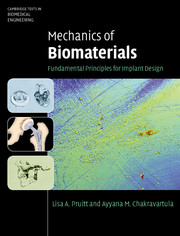Book contents
- Frontmatter
- Contents
- Symbols
- Prologue
- Part I Materials
- Part II Mechanics
- Part III Case studies
- Epilogue
- Appendix A Selected topics from mechanics of materials
- Appendix B Table of material properties of engineering biomaterials and tissues
- Appendix C Teaching methodologies in biomaterials
- Glossary
- Index
- References
Appendix C - Teaching methodologies in biomaterials
Published online by Cambridge University Press: 05 June 2012
- Frontmatter
- Contents
- Symbols
- Prologue
- Part I Materials
- Part II Mechanics
- Part III Case studies
- Epilogue
- Appendix A Selected topics from mechanics of materials
- Appendix B Table of material properties of engineering biomaterials and tissues
- Appendix C Teaching methodologies in biomaterials
- Glossary
- Index
- References
Summary
The field of medical device design is highly multidisciplinary and builds upon a number of specialties including biomaterials science, mechanical engineering, bioengineering, chemical engineering, electrical engineering, integrative biology, public policy, and clinical medicine. With this broad topic comes the challenge of implementing a course that facilitates learning in an interdisciplinary framework. To this end, we have utilized a number of pedagogical techniques to develop an interdisciplinary course entitled Structural Aspects of Biomaterials, from which this textbook was developed. Specifically we have utilized tools such as (1) structured learning objectives based on Bloom's taxonomy; (2) active learning practices and inquiry-based lectures; (3) clinical case studies; (4) professional development utilizing interdisciplinary teams with diversified learning styles; (5) outreach teaching (service-based learning) in the K-12 sector; and (6) criteria specified by the Accreditation Board for Engineering and Technology (ABET).
Structured learning objectives based on Bloom's taxonomy
As there are so many sub-specializations within the field of medical device design it is useful to have distinct learning objectives that are both observable and specific (Anderson et al., 2001). Clearly defined course objectives provide a guide that facilitates the structure of lectures and serves as a study guide for students. In this respect, the application of Bloom's taxonomy (Bloom, 1984) when developing the learning objectives for a course is quite useful. The use of Bloom's taxonomy in the cognitive domain of learning has been updated by Anderson (Anderson et al., 2001) and comprises both lower level thinking skills (remembering, understanding, applying) as well as higher order thinking skills (analyzing, evaluating, creating). Table C.1 shows the ranking (in descending order) of skill levels where Level 6 (L6) represents the highest level of learning (creating) and Level 1 (L1) describes the lowest level of learning (remembering). Creativity is the ultimate outcome for the student and for this reason it is the skill that is listed first in Table C.1. Ideally, each lecture topic addresses all six levels of learning. More important is that the full span of lower-level and upper-level thinking skills is contained within the course content. An example of course learning objectives (http://www.educationoasis.com) that we have employed in past offerings of the Structural Aspects of Biomaterials course is given in Table C.2.
Information
- Type
- Chapter
- Information
- Mechanics of BiomaterialsFundamental Principles for Implant Design, pp. 611 - 619Publisher: Cambridge University PressPrint publication year: 2011
